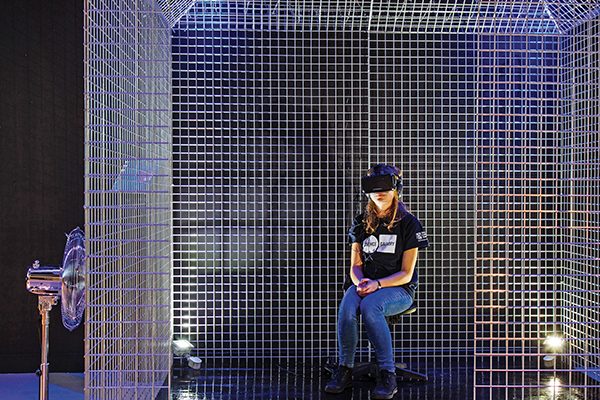
Picture: Friendly staff are on hand to discuss exhibits with visitors.
Science Gallery, the exhibition, theatre and studio space based on the edge of Trinity College campus at Pearse Street, is currently housing an interesting and challenging exhibition entitled ‘Design and Violence: What happens when creativity, art and engineering collide with power, pain and politics?’
This innovative multimedia exhibition is a continuation of Science Gallery’s endeavours to explore and present developments in the converging fields of art, design and science.
Visitors to the Design and Violence exhibition can view a collection of artefacts and art installations, with accompanying interpretive materials, that examine the ways in which art and design intersect with violence and social resistance producing both intended and unintended consequences.
These include objects as diverse as ‘The Liberator’, a 3D-printable gun made of sixteen plastic pieces, the design of which was circulated on the internet before being banned by the US government; the iconic ‘REPEAL’ sweatshirt as recently employed by the Repeal the 8th campaign in Ireland; and the official Fifty Shades of Grey novelty spanking ruler.
Also on display is a number of materials relating to conflict such as a classification chart of drone units employed in war, a display of the various types of landmines used in conflicts past and present, and features that deal with the social implications of conflict such as the ‘Weight of Water’ installation, a virtual reality installation that allows exhibition visitors to experience for themselves a boat journey as faced by refugees seeking asylum on Europe’s borders.
Anyone following the design and physical implementation of development plans in the Dublin 4 area may be interested in features of the exhibition which deal with the social and political aspects of design for public space such as the Camden Bench, a poured concrete public bench commissioned by the UK Camden Borough Council that was created to deter unwanted behaviours such as loitering and criminality, and the controversial ‘anti-homeless spikes’ that have been installed in public spaces to deter people from sleeping rough.

‘Weight of Water’ is a virtual reality installation.
All images courtesy of Science Gallery.
Visitors can encounter these measures for themselves at the exhibition, and a panel discussion on the evening of December 1st entitled ‘Hostile Architecture: Design with Intent’ will further explore the social and political aspects of design as they are expressed in architecture in the Dublin locality.
Design and Violence began as an online curatorial experiment at The Museum of Modern Art, New York, before being developed into its current physical form at Science Gallery. Speaking ahead of the exhibition’s launch on October 13th, one of the project’s originators, curator Paola Antonelli, said: “The exhibition at the Science Gallery Dublin is a thoughtful translation and augmentation of the original Design and Violence project.
The intention of this experiment, in New York, in Dublin, and in any future locale and incarnation, is not to glorify or spectacularize violence, nor to engage in voyeurism or didacticism, but to place these quotidian, theatrical, systemic, and hidden relationships between design and violence into new relief.
Science Gallery Dublin has an amazing record of lively conversation through public engagement with the exhibition visitors. We look forward to the opinions, questions, and actions that will ensue.”
Trinity’s Science Gallery is part of the Global Science Gallery Network that was launched in 2012 with the support of Google.org. The Network aims to establish eight university-linked galleries worldwide by 2020. Based on the model pioneered at Trinity, the Network is set to take the Science Gallery mission global.
The first new gallery will open in London in 2017, followed by galleries in Melbourne and Bengaluru (Bangalore) in 2018. The development of the Network is being driven by Science Gallery International, a non-profit organisation with headquarters in Dublin that is also charged with touring Science Gallery exhibitions worldwide. Exhibitions from Dublin have now toured to thirteen locations internationally, reaching more than 400,000 people in science and art centres across the globe.
The Design and Violence exhibition is open to the public Tuesday to Friday 12pm-8pm and Saturday to Sunday 12pm-6pm until January 22nd 2017 and admission is free. Helpful Science Gallery staff are on hand to discuss the exhibits and assist visitors.
More details on Science Gallery and the Design and Violence exhibition can be accessed online at: dublin.sciencegallery.com. The Science Gallery Network global webpage is available at: international.sciencegallery.com
By Harry Bradley



